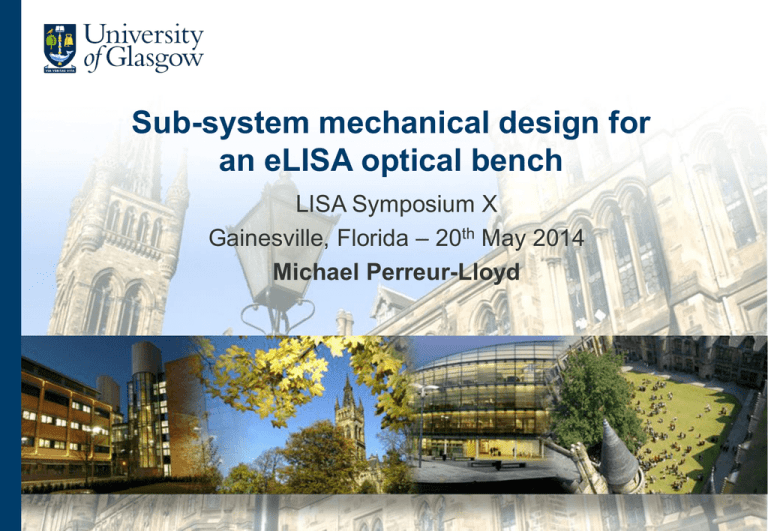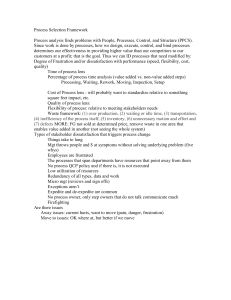Sub-system mechanical design for an eLISA optical bench LISA Symposium X – 20
advertisement

Sub-system mechanical design for an eLISA optical bench LISA Symposium X Gainesville, Florida – 20th May 2014 Michael Perreur-Lloyd Kick-off Scotland v USA FootballE = Soccer AE 1 Kick-off Thanks for staying! You can be my Tartan Army… 2 Kick-off But it’s really more like Europe versus USA… 3 Kick-off But it’s really more like Europe versus USA… …as this is presented on behalf of: University of Glasgow - Christian Killow, David Robertson, Harry Ward Airbus DS - Ewan Fitzsimons, Dennis Weise AEI Hannover - Michael Tröbs, Maike Lieser, Sönke Schuster, Jan-Simon Hennig, Gerhard Heinzel & Karsten Danzmann 4 What? What are we going to build? A test bed to investigate tilt-to-piston coupling in the context of eLISA Which includes: – An Optical Bench with space for an interchangeable imaging system and a Tx Beam – A Telescope Simulator, generating a representative (tilt-able) flat top Rx beam, a local oscillator, and featuring a reference interferometer combining both these beams See poster by Maike Lieser of AEI Hannover This talk is focussed on the Imaging System mechanical design… 5 What? What do the imaging system mechanics need to do? Allow for precision alignment of the lenses & photodiode But, also: be precision adjustable, to allow for characterisation of the designs be removable so as to be replaced by the alternative design 6 What? What are the imaging system optical designs like? Two designs to test and compare different optical design approaches – Two lens, non-classical optics – Four lens, classical optics see poster by Sönke Schuster of AEI Hannover 7 Specifications Alignment Typical alignment specifications for an lens – Decentre, X, Y: +/- 20um – Distance tolerance Z to next lens: +/- 50um – Lens centring: +/- 3’ (or ~1 mrad) – Lens tilt (pitch): +/- 3’ (or ~1 mrad) Characterisation Maximum required range: – Decentre X, Y: +/- 60um – Distance tolerance Z to next lens: +/- 200um – Lens pitch/yaw: +/- 10’ Resolution of movement: – Micron – Sub arc-minute (~100s of urad) 8 Detailed design Design Details To – allow for alignment and characterisation of the imaging system Adjustment mechanisms of individual mounts require: • Lateral, X and Y • Longitudinal, Z • In-plane rotation (yaw) • Out-of-plane rotation (pitch) – Adjustment of lens pair assemblies is required in • Lateral, X and Y • Longitudinal, Z • Yaw • Pitch 9 Detailed design Imaging system optical designs Two designs to test and compare different optical design approaches – Two lens, non-classical optics – Four lens, classical optics 10 Detailed design Design features Four lens design Beam height of 20mm above the Zerodur baseplate A 20 lot of adjustment mechanisms to fit in a small space! 11 Detailed design Design features Four lens design Flexure-adjuster QPD mount Field stop adjuster mechanism Front twin lens adjuster mechanisms Rear twin lens adjuster mechanisms Individual lens mount & adjuster mechanisms 12 Detailed design Design features Two lens design Individual lens mount & adjuster mechanisms Flexure-adjuster QPD mount Lens-pair adjuster mechanisms Individual lens mount & adjuster mechanisms 13 Detailed design Design features Individual lens holders (1) Overall – design is thermally-stable in the vertical direction Through a combined titanium & aluminium architecture Customised – for different lens diameters 6, 8, 10, 12.7 & 13mm Titanium (Frame) Aluminium (Flexure Mechanism) Aluminium (Lens Mount) Thanks to Harald Kögel (Airbus DS) who designed and successfully tested a 25mm version of this optical mount 14 Detailed design Design features Individual lens holders (2) Vertical and pitch adjuster mechanisms Ultra-fine Flexure pitch screws, M2.5 x 0.20 pivot 15 Detailed design Design features Individual lens holder (3) Lateral adjuster allows up to +/-0.3mm of movement range FE analysis of flexure mechanisms – Lateral-adjustment flexure mechanism 16 Detailed design Design features Individual lens holder (4) Longitudinal & Yaw adjusters Central screw pushes and pulls, and acts against a spherical bearing surface to allow pivoting Side screws push to pivot the lens mount 17 Detailed design Design feature summary Individual lens holders have 5 DoF adjustment Fine adjustment (~few micron accuracy) – Vertical – Longitudinal – Lateral – Pitch – Yaw Individual lens holders are mounted in a two lens holder sub-assembly 18 Detailed design Design features Lens pair assembly (1) The lens pair sub-assembly may also be moved longitudinally and laterally and rotationally (in yaw) by pushing on the green adjustment arms with precision thumb screws. 19 Detailed design Design features Lens pair assembly (2) Clamping to titanium baseplate is made using an aluminium ‘bridge’ with a central spring plunger screw to provide the downward force Cross-section view of the lens pair assembly Clamping ‘bridge’ mechanism 20 Detailed design The fully assembled imaging system Overall assembly on its titanium super-baseplate may be moved into position with micron hammers, and precision thumb screws (temporarily mounted on the OB). The super-baseplate, sits on its three ball-bearings, is locked in position via three lever-clamps. 21 Testing Do we know it is all going to work? Our flexure-adjuster PD mount design derives from a COTS flexure mount which was tested in conjunction with the CMM. Micron-level – adjustments were possible. The COTS design although bigger had identical ultra-fine pitch screws. Left: COTS flexure mount; Right: Assembled prototype 22 Testing Do we know it is all going to work? Mounting the QPD into a MACOR interface collar using a 5 DoF translation stage and an optical CMM First try we have achieved so far only partially successful – sub-100micron precision of alignment Improvements to the technique, interface collar design and a little more care to get to the sub-10micron alignment required 23 Testing Do we know it is all going to work? Additionally we have now tested a prototype of the flexureadjuster PD mount – albeit a different design that has flexure feet to allow permanent glue attachment to a Zerodur baseplate Design was then built in to a fibre injector stability experiment Left: PD Mount design for interchangeable imaging systems experiment; Centre: Prototype PD Mount design; Right: Assembled prototype 24 Testing FIOS stability experimental set-up FIOS Two with two beam splitters and three QPDs on a Zerodur baseplate of the QPDs are mounted to Zerodur posts Third QPD is attached to the prototype mount 25 Testing FIOS stability experimental set-up Experiment Positive is still a work in progress… initial results regarding the QPD mount stability – Graph below shows the difference in movement between a ‘perfectly stable’ Zerodur mounted QPD and the Ti-Al mount – Temperature cycle starts at ~25degC dropping to 10degC and rising to ~30degC 26 Conclusions We have a challenging time ahead to assemble and test the imaging systems! Can these imaging system mechanics be used in future for eLISA? Yes, because: – The majority of the components in the design are from materials suited to the space environment – (fused silica optics, Al, Ti, etc.) No, because: – The mechanisms were specifically designed for the requirements of this task – (it is unlikely that we would want them to be removable!) But, we will gain a strong understanding of the imaging systems optical design and this knowledge will lead directly into the OB design for eLISA. And, we in Glasgow, have great experience in precision alignment of optics and robust methods of attaching them to Zerodur. 27 Final Scores The last time they met it was… 28 Final Scores The last time they met it was… …and we’ll gloss over the fact that Scotland won’t be in Brazil this year! … 29 Final Scores …and we’ve yet to find out who will win in this year’s Ryder Cup… 30 Final Scores …and we’ve yet to find out who will win in this year’s Ryder Cup… Of course, this is not about being competitive! In Glasgow, it would be our pleasure to collaborate on eLISA with the USA, and for that matter all of our LISA friends around the globe. Thank you. 31






